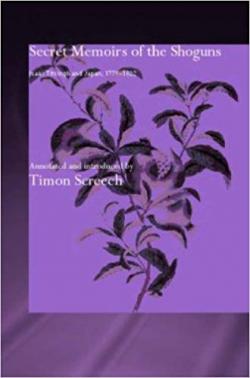Secret Memoirs of the Shoguns: Isaac Titsingh and Japan, 1779-1822

Annotated and introduced by Timon Screech
Routledge 2005
ISBN-13: 978-0700717200
Review by Sir Hugh Cortazzi
Isaac Titsingh was one of the more interesting and intelligent heads of the Dutch trading post at Dejima off Nagasaki. He first went to Japan in 1779 and spent some forty-four months there before his final departure in 1784. He wanted to compile a compendium of papers based on translations from Japanese sources, covering 'all there was to know about the shogun's realm'. Unfortunately the project was too great for any one man and it is not clear how proficient he really became in Japanese. He was also not a finisher. When he died in 1812 he 'had virtually nothing in print'. However, a French edition of some of his papers appeared in 1820 entitled Mémoires et anecdotes sur la dynastie régnante des djoguns. This text was translated into English and published in 1822 under the title of Illustrations of Japan.
Professor Screech's edition presents selections from the English version. Part I consists of the 'Secret Memoirs' which is largely a series of anecdotes about the shoguns and their entourage. Some of these shed an interesting light on life and mores in Tokugawa Japan but cannot claim to be a history of the shoguns. Part II includes a series of 'essays on Japanese civilization' including a short account of Japanese ritual suicide, a subject which clearly fascinated Titsingh who often refers to it in his 'anecdotes'. His essay on Japanese poetry is mainly concerned with satirical verse and as Screech notes his translations 'are not particularly close'. The main item in Part III 'Other Observations' is the so-called 'Secret Diary' of Isaac Titsingh which deals principally with his negotiations with the Japanese on trade matters. The final item is 'Titsingh's 'Philosophical Discourse', an essay sent by Titsingh to his friend Goto Shozaemon, head of the Nagasaki office. Screech comments that this discourse marks 'an important moment in the transmission of Enlightenment thought in Japan'.
The introduction of seventy-four pages includes much fascinating information about Titsingh's life and career. After leaving Japan, Titsingh served in Bengal where he met the famous Indian diarist William Hickey. He later led a Dutch Mission to Peking. Sadly his collection of artefacts which he had received in his ambassadorial collection was lost. But when he was in London during the Napoleonic wars he met Sir Joseph Banks, the president of the Royal Society to whom he donated his collection of minerals from Japan.
Author Timon Screech discussing the work of Carl Peter Thunberg and Isaac Titsingh at the Daiwa Foundation, 25 January 2007
Screech's introduction contains much of interest about the Dutch life and trade in Japan. He reminds us that one of the tasks imposed by the Japanese authorities on the head of the Dutch was to report on events in the rest of the world. 'Always the VOC [The Dutch East India Company] filtered out what it was not in their interest for the shogunate to know, though Edo sometimes found out such matters via the Chinese.' Towards the end of the eighteenth century there was an increasing interest in the outside world. The Komo Zatsuwa (Tales of the Red-haired Barbarians) published in Japan in 1787 after Titsingh had left was often inaccurate but it carried a print of a hot air balloon oddly described as being called 'Tuilleries'.
The Dutch found it very frustrating having to deal with the bureaucracy of the bakufu. The Dutch interpreters were often more of a barrier than a help to trade. There were too many of them; their linguistic abilities and knowledge were strictly limited. He records that on one occasion two of them came to him 'oozing with pomposity. After much circumlocution, they sang the old song that the governor could not change anything this year…'
In Titsingh's time the main export from Japan bought by the Dutch was copper which they traded in India, but this trade became less and less profitable as European copper reached India. The Japanese governor at one point proposed to export 'Chinese satin, silk pansies [sic] and gold bullion in return for bird's nests'. Titsingh rejected this arguing that the Dutch traded direct with China. The Japanese expected the Dutch to send two ships a year to Japan to trade, but Titsingh found that there was not enough profitable trade to justify the costs of these ships and the number of voyages was cut much to the annoyance of the Japanese.
Titsingh took advantage of the women provided by the Maruyama pleasure quarters but did not father any children in Japan. Screech has some interesting comments on this aspect of the Dutch life in Japan noting that 'the Maruyama was known as the sole accessible site of international sexual encounter, and this spawned many comments, salacious and humorous, and many pictures'(page 45).
Professor Screech has performed a valuable service for students of Tokugawa Japan and of contacts between the West and Japan by resurrecting Titsingh's writings from obscurity. They are not as interesting or informative about Japan as those of the three famous doctors to the Dutch enclave Kaempfer, Thunberg and von Siebold, but they do provide some information which the others did not learn or record.
Related book: Japan Extolled and Decried Carl Peter Thunberg and the Shogun's Realm, 1775-1796,

